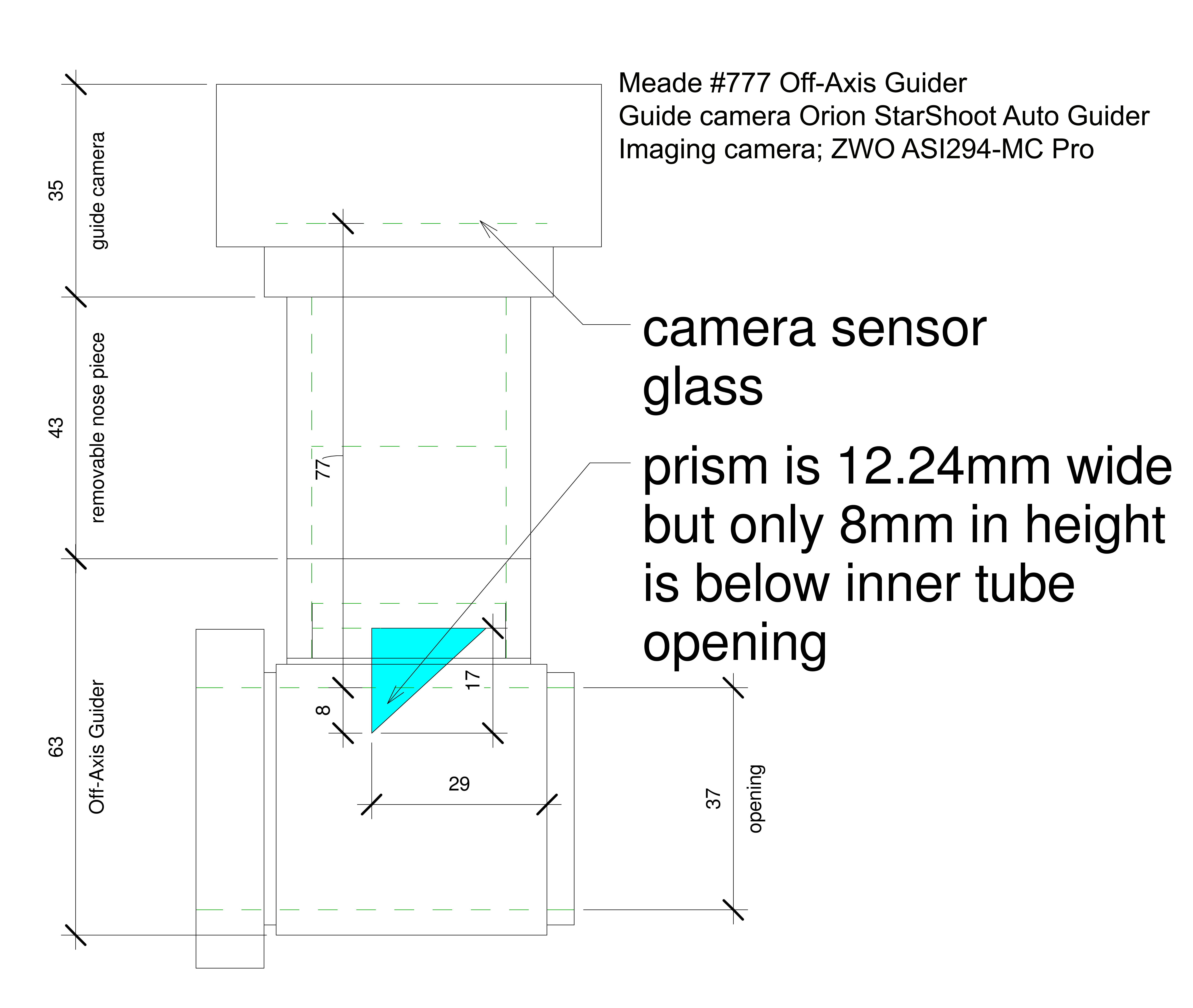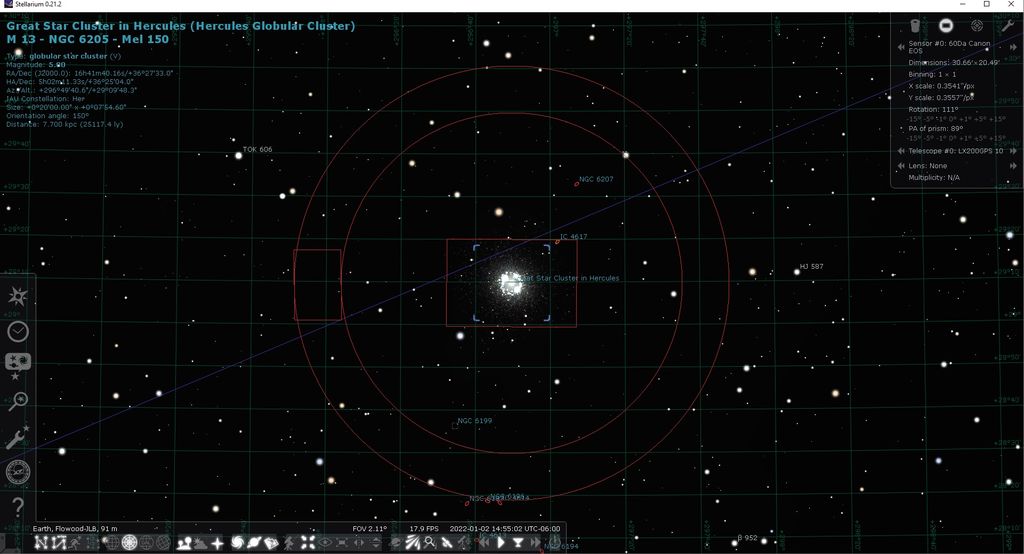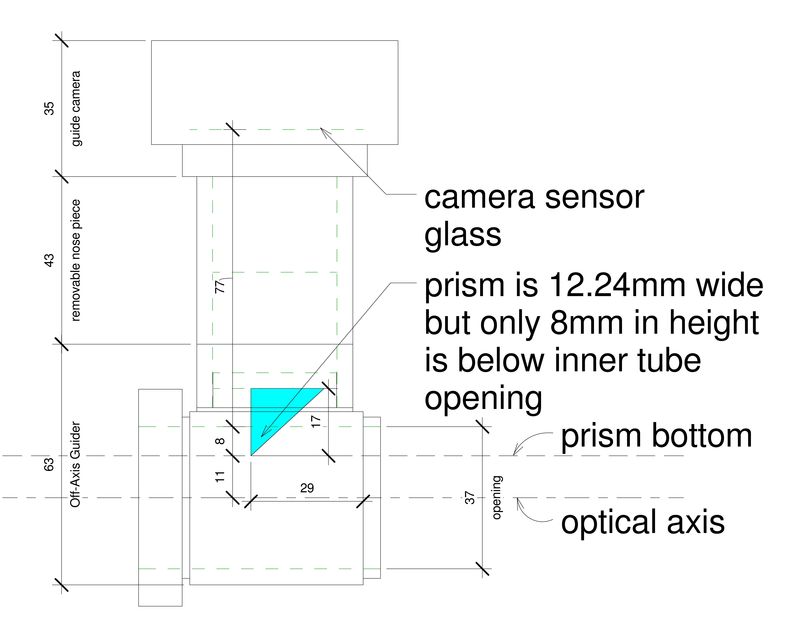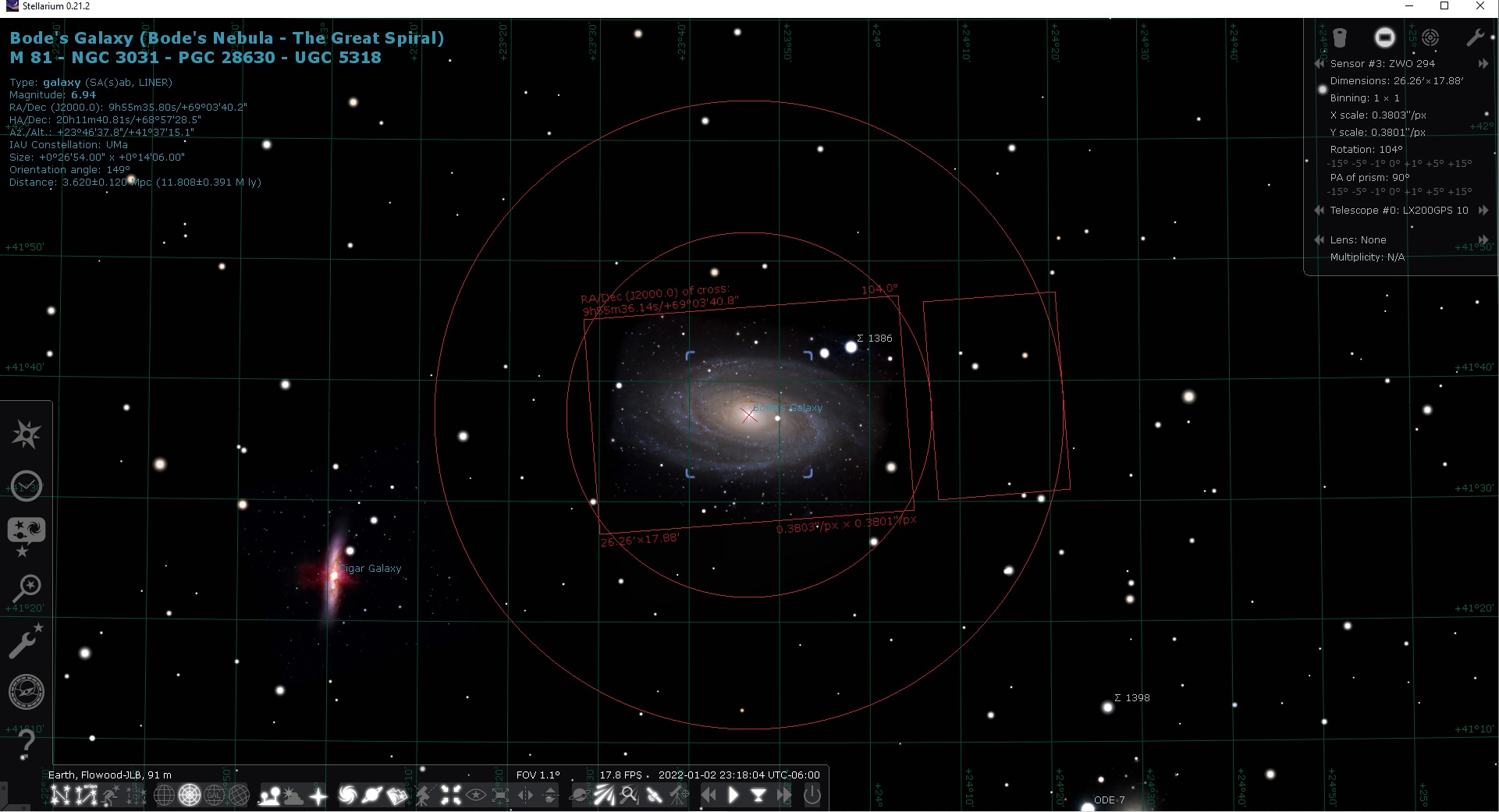Stellarium Off-AXis Guider settings
Gadgetman Bowen
Been watching many YouTube videos on Off-Axis guiding. Several I have seen the person is using Stellarium to view the position of the guide camera’s view in relationship to the image camera’s view. Sometimes the position of the guide camera has to move to get a star and he was preplanning the process and angle. I do not understand the settings in Stellarium for the guide camera. I have attached a jpeg of my Meade #777 Off-Axis Guider that is a CAD drawing I did of the item. I measured all components in Millimeters. I had to do this because the prism, although tall only projects down into the open barrel 8mm. there is no adjustment on the prism to be farther down in the light path. I know that I might have to increase or decrease the distance from the prism to the guide camera sensor to focus. If I have to decrease, I will have to figure a spacer ring system to do that.
With the provided drawing, can anyone aid me in the required figures needed for the four items under the Stellarium Off-Axis guider list that is found in the Oculars window under the Sensors tab? I am thinking 12mm for prism width and 8mm for the prism height, since the height light path is restricted. I assume the Position angle will be 90-degress.
I put in 77+(8/2) = 81mm (which is the distance from center of prism to guide sensor) in the Prism/CCD distance but that really looked odd. Then I changed it to 20mm just to see what that looked like.
One of the many I have watched; https://www.youtube.com/watch?v=x_Od8hp7dg0&ab_channel=JamesLamb

Hope to hear from someone.
Thank you,
Jerry
chris hanson
axis of telescope in mm.
Prism/CCD width – the width of the prism/CCD of Off-Axis Guider in mm.
Prism/CCD height – the height of the prism/CCD of Off-Axis Guider in mm.
Position Angle – the position angle of the prism/CCD of Off-Axis Guider, in degrees.
The resolution is easy to find: these are simply the image dimensions of a (non-binned) frame. The
chip size and pixel size may be more difficult, but the manual, or searching the Internet, should turn
up these values. For a “full-frame” DSLR, this should be close to 36x24mm, while APS-C should
be around 22.5x15mm. Some cameras may have unsquare pixels.
chris hanson
chris hanson
Gadgetman Bowen


chris hanson

axis of telescope in mm.
Prism/CCD width – the width of the prism/CCD of Off-Axis Guider in mm.
Prism/CCD height – the height of the prism/CCD of Off-Axis Guider in mm.
Position Angle – the position angle of the prism/CCD of Off-Axis Guider, in degrees.
The resolution is easy to find: these are simply the image dimensions of a (non-binned) frame. The
chip size and pixel size may be more difficult, but the manual, or searching the Internet, should turn
up these values. For a “full-frame” DSLR, this should be close to 36x24mm, while APS-C should
be around 22.5x15mm. Some cameras may have unsquare pixels.
Gadgetman Bowen


Gadgetman Bowen
chans...@gmail.com
Hi Jerry,
Yes you you’ve got it now. If your prism is adjustable you can move it out to clear the sensor as needed and update your Prism/CCD distance respectfully.
Chris
From: stell...@googlegroups.com <stell...@googlegroups.com> On Behalf Of Gadgetman Bowen
Sent: Sunday, January 2, 2022 11:43 PM
To: Stellarium <stell...@googlegroups.com>
Subject: [stellarium] Re: Stellarium Off-AXis Guider settings
I will add that for the Canon EOS 60Da the prism overlaps the sensor frame by a very small amount. However, on the Nikon D70 the prism overlaps the sensor frame by a bit more. May not be using the Nikon D70 anymore for astrophotography. Kind of quit using it after I got the Canon anyway.
On Sunday, January 2, 2022 at 11:34:37 PM UTC-6 Gadgetman Bowen wrote:
I think I got it now. Prism/CCD distance = 11mm, Prism/CCD width = 12mm, Prism/CCD height = 8mm
See attached pictures.
Thank you.
On Sunday, January 2, 2022 at 8:21:35 PM UTC-6 chans...@gmail.com wrote:
Hi Jerry,
First I need to credit ZWO technical drawings for the Telescope and ASI183 drawings, and Jerry for his OAG drawing that I use in the picture I included below.
See my setup diagram below.
You do not measure from the edge of the prism to the T-adapter threads (M42). My prism is 12mm x 12mm and the bottom of the prism is 10mm from the center (Optical Axis) of my OTA. This is the optical train axis. So imaging that there is a line (Optical Axis) running through your OAG to the sensor of the image camera like in the diagram. Measure from the BOTTOM of the prism to the Optical Axis, that is the Prism/CCD Distance (mm) value.
Prism/CCD distance – distance between center of prism/CCD of Off-Axis Guider and optical
axis of telescope in mm.
Prism/CCD width – the width of the prism/CCD of Off-Axis Guider in mm.
Prism/CCD height – the height of the prism/CCD of Off-Axis Guider in mm.
Position Angle – the position angle of the prism/CCD of Off-Axis Guider, in degrees.
The resolution is easy to find: these are simply the image dimensions of a (non-binned) frame. The
chip size and pixel size may be more difficult, but the manual, or searching the Internet, should turn
up these values. For a “full-frame” DSLR, this should be close to 36x24mm, while APS-C should
be around 22.5x15mm. Some cameras may have unsquare pixels.
On Sunday, January 2, 2022 at 3:08:10 PM UTC-6 gadget...@att.net wrote:
To the right of the Off-Axis guider drawing is where the imaging camera will be and to the top is the guide camera. Just to clarify, the horizontal 29 dimension from the vertical face of the prism is to the T-adapter (M42) threads, where either of my camera’s will start their attachment to the Off-Axis guider. At times a focal reducer will be attached to the left side of the Off-Axis guider. So, that dimension 29 is not to the sensor of the imaging camera. I put the 29 where you stated it should go in Stellarium. I assume that the 8 is the height of my prism’s light path, but the prism is taller. And 12 is the width of the light path getting to the prism. Are those two numbers, correct? If so, I am getting an image of the prism way away from the imaging camera’s frame size. The screen shots below are with the ZWO 294 and the Canon 60Da sensors specs. Those camera’s frame sizes are almost identical. File names will show which one is the ZWO and Canon.
On Sunday, January 2, 2022 at 12:31:17 PM UTC-6 chans...@gmail.com wrote:
Hi Jerry,
Sorry for the spam. I double checked and in Stellarium the popup help text says to measure from the BOTTOM of the prism to the optical train axis "your line marked 29". That is what mine is set to as well, BOTTOM, and it works perfect. The square on the Cigar Galaxy is what my prism sees. The goal is to keep the prism from clipping the camera sensor in the center as you rotate the prism to find guide stars. This becomes more important as your image sensor size gets larger. Feel free to ping me with any questions. My prism is 12x12 and distance is 10.
On Sunday, January 2, 2022 at 12:06:46 PM UTC-6 chris hanson wrote:
Jerry,
Just to elaborate. In your picture above you have a line marked with a 29. The distance from the center of the prism to the line marked 29 is the distance to enter in Prism/CCD distance field.
On Sunday, January 2, 2022 at 11:57:02 AM UTC-6 chris hanson wrote:
Hi Jerry,
I use Stellarium for the same purpose. Please note from the Stellarium user guide:
Prism/CCD distance – distance between center of prism/CCD of Off-Axis Guider and optical
axis of telescope in mm.
Prism/CCD width – the width of the prism/CCD of Off-Axis Guider in mm.
Prism/CCD height – the height of the prism/CCD of Off-Axis Guider in mm.
Position Angle – the position angle of the prism/CCD of Off-Axis Guider, in degrees.
The resolution is easy to find: these are simply the image dimensions of a (non-binned) frame. The
chip size and pixel size may be more difficult, but the manual, or searching the Internet, should turn
up these values. For a “full-frame” DSLR, this should be close to 36x24mm, while APS-C should
be around 22.5x15mm. Some cameras may have unsquare pixels.That use the distance from the center if the prism to the center of your optical train (the center of your imaging sensor) not the guide camera.
I hope that helps.
Chris
On Saturday, January 1, 2022 at 12:59:54 AM UTC-6 gadget...@att.net wrote:
Been watching many YouTube videos on Off-Axis guiding. Several I have seen the person is using Stellarium to view the position of the guide camera’s view in relationship to the image camera’s view. Sometimes the position of the guide camera has to move to get a star and he was preplanning the process and angle. I do not understand the settings in Stellarium for the guide camera. I have attached a jpeg of my Meade #777 Off-Axis Guider that is a CAD drawing I did of the item. I measured all components in Millimeters. I had to do this because the prism, although tall only projects down into the open barrel 8mm. there is no adjustment on the prism to be farther down in the light path. I know that I might have to increase or decrease the distance from the prism to the guide camera sensor to focus. If I have to decrease, I will have to figure a spacer ring system to do that.
With the provided drawing, can anyone aid me in the required figures needed for the four items under the Stellarium Off-Axis guider list that is found in the Oculars window under the Sensors tab? I am thinking 12mm for prism width and 8mm for the prism height, since the height light path is restricted. I assume the Position angle will be 90-degress.
I put in 77+(8/2) = 81mm (which is the distance from center of prism to guide sensor) in the Prism/CCD distance but that really looked odd. Then I changed it to 20mm just to see what that looked like.
One of the many I have watched; https://www.youtube.com/watch?v=x_Od8hp7dg0&ab_channel=JamesLamb
Hope to hear from someone.
Thank you,
Jerry
--
You received this message because you are subscribed to a topic in the Google Groups "Stellarium" group.
To unsubscribe from this topic, visit https://groups.google.com/d/topic/stellarium/YGcirJl4xww/unsubscribe.
To unsubscribe from this group and all its topics, send an email to stellarium+...@googlegroups.com.
To view this discussion on the web visit https://groups.google.com/d/msgid/stellarium/f94716de-50d7-4718-8e6a-b222d67e99b2n%40googlegroups.com.
